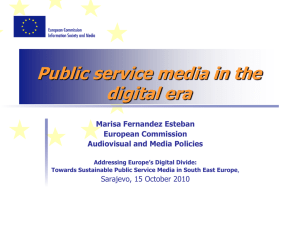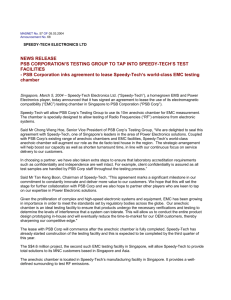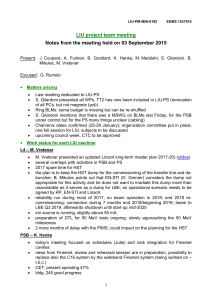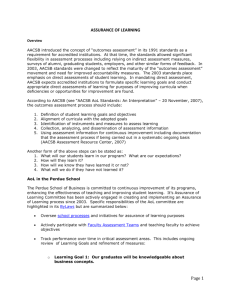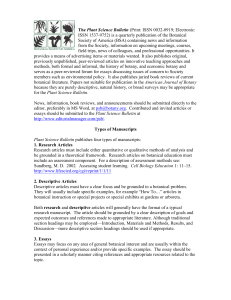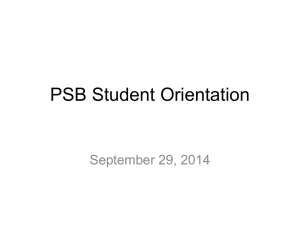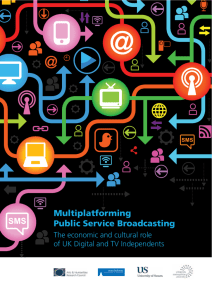Public Service Broadcasting in the Internet Age - Stakeholders
advertisement
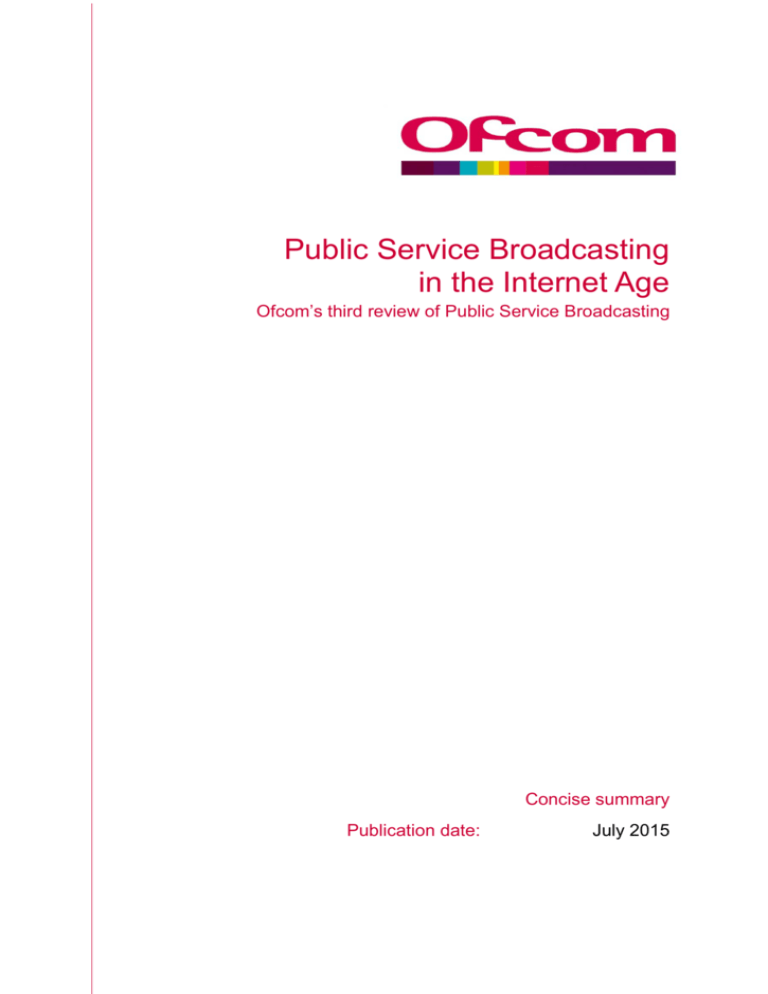
Public Service Broadcasting in the Internet Age Ofcom’s third review of Public Service Broadcasting Concise summary Publication date: July 2015 1 Concise summary Introduction This document is a brief high-level summary of Ofcom’s third review of Public Service Broadcasting (PSB). The full review document was published in July 2015, and is available here: http://stakeholders.ofcom.org.uk/consultations/psb-review-3/statement/ In 2005, the first review set out the challenges and potential responses to the move from analogue to digital broadcasting. A second review in 2009 addressed concerns arising from that transition, and the effects of lower advertising revenues in the face of the financial crisis. Now, in the fast-moving tide towards consuming media over the internet, this third review looks at how PSB is faring today; the opportunities and threats; and what’s changing in terms of technology, media provision and the way audiences behave. PSB: what it is, where it is PSB is not a requirement laid down by Ofcom. It is legislated for by Parliament, which requires high-quality content, made for as wide a range of audiences as possible, and for public benefit rather than purely commercial ends. PSB’s mission is essentially the same as Lord Reith’s original BBC dictum “to inform, educate and entertain”. Crucially, it should be available to all. The five main PSB channels account for over half of all TV viewing. PSB reaches across the UK via the BBC, C4C, the Channel 3 licensees (ITV plc, STV and UTV) and Five. BBC Alba and S4C provide Gaelic and Welsh language services. While all BBC services are PSB, only the main channels of the other broadcasters are PSB services. In return for delivering PSB (channels or programmes or obligations), the broadcasters get certain benefits: chiefly, access to spectrum - the valuable radiowaves that broadcast their services - as well as prominence on electronic programme guides (EPGs). In the BBC’s case, the chief benefit is their income from the Licence Fee. PSB brings significant benefits to us all. It ensures diversity in the media, plurality in news and it drives programming that reflects and examines society as a whole. Economically, it supports the wider creative industries, and in particular the independent production sector. Non-PSB commercial broadcasters are also providing more content that meets many of the PSB objectives, creating greater choice for audiences. However, their scale of investment remains modest when compared to the PSBs. This review Our starting point for this review is the UK audience, both as consumers of media and, more widely, as citizens in society. We have carried it out against the backdrop of the internet taking an increasingly central place in people’s lives. Live television remains hugely important, but catch-up TV and content premiered online is increasingly significant to audiences, especially younger ones. In fact today, only 50% of 16-24s’ viewing, and 61% of 25-34s’, is watched when it’s actually 1 broadcast. Viewing of live TV news by young people also dropped, by 29%, between 2008 and 2014. Of course, PSB programmes are also available on demand; for example, BBC iPlayer and Channel 4’s All4 1 have extended the reach of PSB programmes. However, changes in technology and audience behaviour set new challenges for PSB. Our review is the product of consultation and analysis over a 12 month period. The consultation document we issued is available here: http://stakeholders.ofcom.org.uk/binaries/consultations/psb-review-3/summary/PSBR-3.pdf We received around 70 responses, had a significant number of meetings with stakeholders from across the sector, and conducted and commissioned analysis across the range of issues covered in our review statement. 1 All4 carries both content from the core PSB service, Channel 4, the portfolio channels and some content commissioned specifically for online. 2 2 A summary of the review’s findings and conclusions We have found that, in the round, PSB in the UK is in good shape, has many strengths and is well received by the viewing public. However, there is more to do if it is to meet the needs of all audiences. The trend towards online viewing may also affect PSB’s ability to deliver against Parliament’s expectations, and pose increasing challenges to funding. 1. PSB as it is currently delivered Taken as a whole: • PSB is broadly delivering what Parliament requires. The BBC remains the cornerstone of the PSB system and is the key driver of investment across it. In 2014 PSBs spent a total of £2.5bn on new UK original content (including sport), with just over half coming from the BBC at £1.27bn. ITV, Channel 4 and Channel 5 contributed the rest (£1.25bn). • Audience satisfaction is running high. Viewers look to PSB for a variety of core strengths, including news they can trust, a service that reflects their nations and regions, a full diversity of British cultures, and high-quality soaps and drama. Our annual surveys have shown that PSB is delivering rising overall satisfaction across these purposes and characteristics, from 69% in 2008 to 79% in 2014. • News remains the most important PSB genre. Overall, PSBs still account for 95% of TV news viewing 2, with multichannel providers such as Sky and CNN ensuring there’s a wide choice. Adult audiences for TV news remain broadly stable, but internet consumption is growing. In 2014, 41% of adults used the internet as a source of news (2007: 16%). The most marked change is coming from young people: nearly half now regard online as their news source of choice. However, concerns remain: 2 • Investment in new, UK originated content by PSB channels has fallen by over £400m in real terms during the period 2008-2014. The primary measurement we use is spend on original UK content, which is the best proxy for the range of outcomes specified in the legislation. However, we acknowledge that this focuses on inputs rather than outputs and therefore does not address whether reduced spend is a result of increased efficiency or reduced output. Broadcasters have responded to this fall by achieving savings in programmemaking costs and cutting their cloth in terms of the types of programmes they produce. • Immediate areas of concern have emerged. These include news consumption and the provision of news for young people; drama that reflects British society to a British audience; content tailored to the specific needs of the Nations and their regions; religious programming, children’s programming and investment in minority areas such as music and the arts. There are also emerging concerns Source: BARB, Individuals 4+. 3 about older people’s satisfaction with the PSB system, and questions about how far young people distinguish public service broadcasting from other content. • The Nations and their regions. This is where the greatest mismatch exists between the public’s expectations of PSB and what it actually delivers. For example, plurality remains a concern in Wales. Northern Ireland has benefitted least from increases in network programme production across the UK nations since 2008. In Scotland, we’ve received concerns about the sustainability of the local production sector. Viewing in some areas is also down; for example, the amount of viewing per person per year of news for each of the four Nations and their regions has declined by over 4 hours since 2008.These important issues, coupled with the ongoing programme of devolution in the UK, have led us to publish a separate document on the specific needs of audiences in the Nations and regions. You can see it here: http://stakeholders.ofcom.org.uk/binaries/consultations/psb-review3/statement/PSBR_natreg.pdf • Great drama masks a dwindling investment. Although PSB still delivers some big-budget, landmark productions, the reality is that first-run, UK-originated spending by PSBs has fallen by 44% since 2008. The time-shifting of over a fifth of UK drama viewing brings commercial challenges, and can make international markets all the more important. Although audience satisfaction remains stable, drops in investment and hours of new output, particularly on ITV, are a concern. • Some genres are getting minimal attention. Since the removal of quotas by legislation in 2003, PSB has significantly reduced its coverage of classical music and the arts, religion and ethics, and formal education. Also, outside of the BBC, non-animation children’s content is very limited. • Negative portrayal and under-representation. Broadcasters need to do more in researching, understanding and addressing concerns of particular audiences. In particular, over half of the people from black communities who took part in our research felt both under-represented and unfairly portrayed, while around half of the disabled people we talked to felt under-represented. 2. The shift to online and its challenges for PSB 4 • PSB funding could be under pressure in an online world. Younger audiences’ viewing behaviour may be the precursor to a general shift to online and on-demand across all age groups. PSB’s current funding challenges may then become even greater, as technology affects how people choose and access content. • PSB could struggle to continue to deliver its remit. If we see acceleration in the trend towards online and on-demand, the PSB system is likely to struggle to deliver Parliament’s intentions. Indeed, if the pace of change is particularly marked, the current PSB benefits of access to spectrum and prominence on EPGs will become increasingly less relevant. • PSBs need to be free to innovate. Increasingly, audiences are looking for more than just traditional TV content from PSBs. Broadcasters will need to answer the demand for content delivered over multiple devices, and which is specifically designed for the internet environment. Short-form video or online-first content has the potential to deliver key PSB purposes effectively. • Online growth means continuing opportunities for others. PSB-type content will come from the commercial and wider public sectors. Examples already include companies such as Vice Media providing news content to younger people; local news and content by hyperlocal websites; and major universities putting their lectures online. 3. The emerging issues from this review • PSBs are well placed to raise their game. In an increasingly connected environment they have strong brands with portfolio channels and on-demand players. This, coupled with their significant reach and impact in linear television, means they are well placed to take advantage of the opportunities provided by the internet and to deliver public service outcomes in new and fresh ways. • The current PSB system needs to adapt. The review highlights various immediate areas of concern; these, together with accelerating online trends, suggest that PSB needs to adapt further. If they’re to maintain high levels of funding for PSB content, they will need to maximise commercial revenues and deliver efficiencies. • As the online trend grows, so do funding challenges. PSB’s aims are set by Parliament; it is valued by its audiences; and it plays a vital role in supporting the wider creative sector. But there’s a growing question whether the interventions it enjoys will continue to be enough. If broadcasters struggle to increase commercial revenues and efficiencies, they may face increasingly tough choices about which content and services they can fund. One area’s gain may have to be another’s loss. • The BBC’s Charter Review will be critical for PSB. Any significant changes in the scope or nature of the output of the BBC could have a material impact on its ability to deliver the outcomes set by Parliament. However, this is a matter for the Charter review process rather than this review. Ofcom has not, in the course of this review, conducted a detailed analysis of the BBC’s ability to maximise its commercial revenues, realise further efficiencies or refocus its activity to provide greater value for money. • Channel 4 may benefit from help to meet the needs of younger audiences. There may be a case for updating the framework within which C4C operates to recognise that the media consumption habits of younger audiences are changing rapidly. This could include allowing C4C to deliver some of the obligations which are attached to its core Channel 4 service across the range of its services, and guaranteeing that its channels and services, which are used to deliver public service content, are given prominence on the most popular user interfaces. • The rules that give PSB prominence need reform. Although there are measures in place to guarantee schedule prominence for PSBs, these were designed for the analogue era. Policymakers should give further consideration to reforming the rules and recognising changes in technology. • Reforming the regulation which may affect the flow of funds between platforms and broadcasters (the so-called ‘retransmission fees’ debate). Reform might be productive, although it could also require complicated and lengthy backstop regulatory determinations to resolve commercial 5 disagreements. Also, there is currently no guarantee that all additional funds it generated would be spent on public service content. 6 • Consolidation of independent production: benefits and risks. Consolidation might encourage overseas investors to provide more risk capital to fund commissions from PSBs. Equally, it could put at risk new entrants and those SMEs who have formed the backbone of the UK television production sector in the past decade. It is too early to assess the full impact of market consolidation and we will keep this area under close review. • Finally: the unknown international impact. The UK’s creative sector, and the PSB system within it, is increasingly operating in a more international context. The full effects of international players acquiring UK broadcasters and production companies; and global exploitation of content; and, in particular, the impact of new online players, are not yet clear. The market is evolving quickly and will need to be monitored carefully, given the potential risks to the success of the PSB system and the UK production sector.
